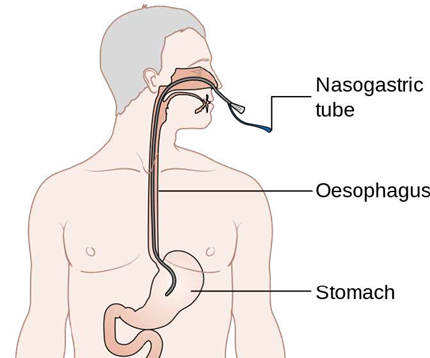The nurse caring for a client reviews the medical record and determines the client is at risk for developing a potassium deficit because of which situation?
History of Addison's disease.
Has sustained tissue damage.
Uric acid level of 9.4 mg/dL.
Requires nasogastric suction.
The Correct Answer is D

Nasogastric suction removes gastric secretions that contain potassium, leading to a loss of potassium from the body. This can cause hypokalemia, which is a low level of potassium in the blood.
Choice A is wrong because Addison’s disease causes hyperkalemia, which is a high level of potassium in the blood.
Choice B is wrong because tissue damage can release potassium from the cells into the blood, causing hyperkalemia.
Choice C is wrong because uric acid level is not related to potassium level.
Uric acid is a waste product of purine metabolism that can cause gout or kidney stones if elevated.
Nursing Test Bank
Naxlex Comprehensive Predictor Exams
Related Questions
Correct Answer is B
Explanation

Hyponatremia is a condition where the serum sodium level is below 135 mEq/L, which can affect the normal functioning of cells, muscles, and organs.
Administering intravenous fluids with a high sodium content can help restore the sodium balance and prevent complications such as confusion, seizures, and coma.
Choice A is wrong because encouraging the patient to consume a low-sodium diet would worsen the hyponatremia and increase the risk of electrolyte imbalance.
Choice C is wrong because administering a diuretic medication to increase urine output would cause further fluid and sodium loss and exacerbate the hyponatremia.
Choice D is wrong because encouraging the patient to increase fluid intake would dilute the sodium concentration and lower the serum sodium level.
Correct Answer is ["B","C","D"]
Explanation
Hypercalcemia is a condition in which the calcium level in the blood is above normal.

This can cause various symptoms, such as confusion, constipation, and bradycardia (slow heart rate).
These are the clinical manifestations that the nurse would expect to observe in a client with hypercalcemia.
Choice A is wrong because muscle spasms are not a common symptom of hypercalcemia.
In fact, hypercalcemia can cause muscle weakness and pain.
Choice E is wrong because polyuria (excessive urination) is not a direct symptom of hypercalcemia, but rather a result of kidney problems caused by hypercalcemia.
Hypercalcemia can make the kidneys work harder to filter the excess calcium, leading to dehydration and thirst.
However, this does not necessarily mean that the client will have polyuria.
Normal ranges for calcium levels in the blood are 8.5 to 10.2 mg/dL (milligrams per deciliter) or 2.1 to 2.6 mmol/L (millimoles per liter).
Whether you are a student looking to ace your exams or a practicing nurse seeking to enhance your expertise , our nursing education contents will empower you with the confidence and competence to make a difference in the lives of patients and become a respected leader in the healthcare field.
Visit Naxlex, invest in your future and unlock endless possibilities with our unparalleled nursing education contents today
Report Wrong Answer on the Current Question
Do you disagree with the answer? If yes, what is your expected answer? Explain.
Kindly be descriptive with the issue you are facing.
